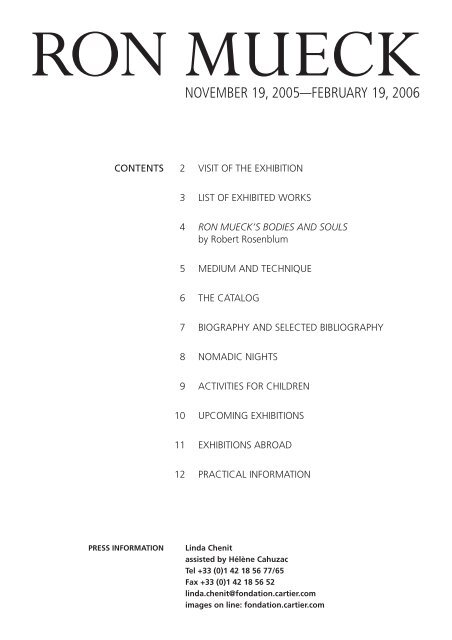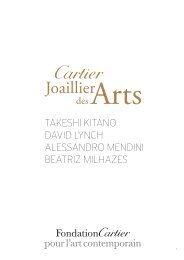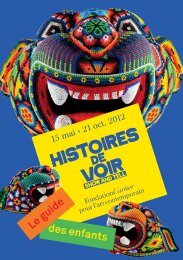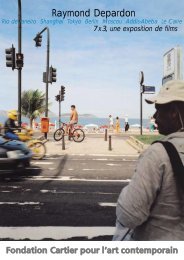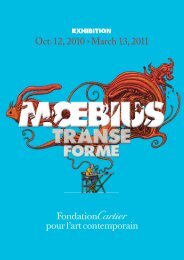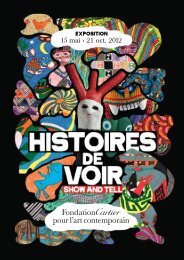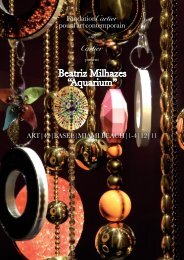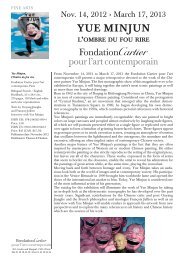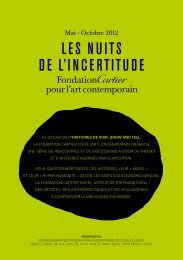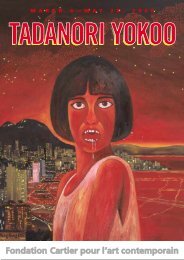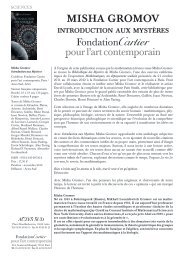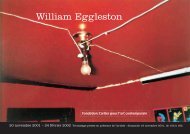Download - Fondation Cartier pour l'art contemporain - Cartier
Download - Fondation Cartier pour l'art contemporain - Cartier
Download - Fondation Cartier pour l'art contemporain - Cartier
Create successful ePaper yourself
Turn your PDF publications into a flip-book with our unique Google optimized e-Paper software.
RON MUECK<br />
NOVEMBER 19, 2005—FEBRUARY 19, 2006<br />
CONTENTS 2 VISIT OF THE EXHIBITION<br />
3 LIST OF EXHIBITED WORKS<br />
4 RON MUECK’S BODIES AND SOULS<br />
by Robert Rosenblum<br />
5 MEDIUM AND TECHNIQUE<br />
6 THE CATALOG<br />
7 BIOGRAPHY AND SELECTED BIBLIOGRAPHY<br />
8 NOMADIC NIGHTS<br />
9 ACTIVITIES FOR CHILDREN<br />
10 UPCOMING EXHIBITIONS<br />
11 EXHIBITIONS ABROAD<br />
12 PRACTICAL INFORMATION<br />
PRESS INFORMATION Linda Chenit<br />
assisted by Hélène Cahuzac<br />
Tel +33 (0)1 42 18 56 77/65<br />
Fax +33 (0)1 42 18 56 52<br />
linda.chenit@fondation.cartier.com<br />
images on line: fondation.cartier.com
RON MUECK<br />
NOVEMBER 19, 2005—FEBRUARY 19, 2006<br />
VISIT OF THE EXHIBITION<br />
In the mid-nineties, Australian artist Ron Mueck redefined realism as an aesthetic,<br />
thus renewing the language of contemporary sculpture. The <strong>Fondation</strong> <strong>Cartier</strong> <strong>pour</strong> l’art <strong>contemporain</strong> is<br />
pleased to present the first solo exhibition in France of this exceptionally gifted artist whose renown has spread<br />
internationally in just a few years. The <strong>Fondation</strong> <strong>Cartier</strong> has given the sculptor the entire ground floor level;<br />
the transparency of the building’s glass-enclosed spaces offers a spectacular setting for his works. The<br />
exhibition presents a series of five new pieces created specially for the occasion. The naked Wild Man is a large<br />
seated figure who appears tense and fearful. Spooning Couple represents a man and woman lying in bed<br />
together in a foetal position, suggesting both intimacy and solitude. Mask III is the portrait of a black woman<br />
wearing an expression of peace and content. Two Women depicts a pair of elderly ladies gazing off into the<br />
distance. In Bed portrays a giant female figure who is gently waking up in her bed.<br />
With these new pieces, Ron Mueck continues to explore reality’s ambiguous relationship<br />
to artifice. Brillantly employing the strategies of imitation and illusion, he creates figures that express the<br />
contradictions between the real world and the world of the imaginary. His figures are so lifelike that we<br />
instinctively expect them to begin breathing. Veins, wrinkles, sagging skin, moles, body hair, rashes… every<br />
detail has been crafted to such perfection that the remarkably convincing result can be disturbing.<br />
The artist, who began his career creating marionettes, does not strive to reproduce reality<br />
as we perceive it; by scrupulously imitating each of nature’s details, he gives life to strange and unsettling<br />
figures. The onlooker is automatically disconcerted by their size, always larger or smaller than human scale (the<br />
crouching figure Boy, his most famous piece, is five metres high). Similarly, certain anatomical proportions may<br />
be stretched and accentuated, or the subject’s posture might appear untenable. The artist’s manifest sensitivity<br />
as well as his technical mastery of his materials enable him to create this ambiguous sense of realism. After<br />
years of sculpting with fibreglass alone, Ron Mueck now also works with the more flexible silicone, which<br />
allows him greater ease in shaping certain body parts, such as hands and heads, and in implanting individual<br />
hairs. Yet the extraordinary subtlety of Mueck’s work dwells first and foremost in its power to evoke, to suggest.<br />
Beyond their physical presence, Ron Mueck’s figures express individual emotions and experiences. Accessories<br />
such as a piece of clothing or some bed linens hint at a plot, suggesting a larger environment that allows each<br />
viewer to elaborate his own personal narrative. Every work of art expresses an individual, intimate state where<br />
the stuff of artistic realism shifts toward the realm of psychology. Through their emotional power, Ron Mueck’s<br />
pieces surprise and fascinate. These characters are meant to be observed slowly, so that the shock of the first<br />
glance can gradually be replaced by the dynamics of imagination. Each of Mueck’s hyper-sensitive creations<br />
presents a curious mirror of reality that conveys observers towards a hidden dimension of themselves.<br />
Wild Man, 2005<br />
112 1 /8 x 63 3 /4 x 41 1 /3 in.<br />
A naked, bearded man with tousled hair and a wild appearance is clutching the stool he is seated upon. His<br />
tense body and oblique gaze echo the profound angst the environment provokes within him. For this<br />
sculpture, Ron Mueck makes use of the <strong>Fondation</strong> <strong>Cartier</strong>’s physical structure by extending the exhibition space<br />
into the surrounding garden. His character is placed against a natural background from which he seems to<br />
have emerged against his will, only to be exposed to the unwelcome scrutiny of viewers. His silhouette, visible<br />
from the Boulevard Raspail, invites passers-by to come discover the phantasmagorical universe of Ron Mueck.<br />
2
Spooning Couple, 2005<br />
5 1 /2 x 25 5 /8 x 13 3 /4 in.<br />
A man and a woman, lying naked side by side, are caught in the intimacy of light sleep. The absence of physical<br />
contact between them belies the apparent serenity of the scene. As a result, physical presence mutates into<br />
absence, closeness becomes distance, and the comfort of two is transformed into the solitude of one.<br />
Among Ron Mueck’s sculptures, this piece is exceptional: it is the first time that the artist has left the theme of<br />
a single character behind in order to focus on the relationship between two people.<br />
Mask III, 2005<br />
61 x 52 x 44 1 /2 in.<br />
Mask III follows Ron Mueck’s self-portraits Mask (1997) and Mask II (2001). Inspired by a striking woman of his<br />
acquaintance, Mueck has created a third mask that is his first portrait of a woman of colour. The munificence<br />
of her radiantly smiling face is the artist’s tribute to this feminine beauty.<br />
Two Women, 2005<br />
33 1 /2 x 18 7 /8 x 15 in.<br />
Here, as in Spooning Couple, Ron Mueck introduces the observer to a pair of characters bound by a common<br />
experience. Two elderly ladies, presented together, are gazing in the same direction. The artist had previously<br />
evoked old age through solitary old women whose patent introversion suggested suffering or loneliness. In<br />
this piece, the women are looking not inward, but outward: the constraints of the private sphere are left<br />
behind in favour of an unrestricted openness.<br />
In Bed, 2005<br />
63 3 /4 x 255 7 /8 x 155 1 /2 in.<br />
A woman in her forties is in bed, propped up on some pillows. Fresh out of sleep, she is holding her face with<br />
her right hand and appears to be lost in her reflections.<br />
As with Boy, the enormous squatting lad first shown at the Venice Biennale in 2001, Ron Mueck has created<br />
a new piece of monumental dimensions. Intimidating the viewer through her sheer size, deeply absorbed in<br />
thought, the woman in bed may evoke loneliness, melancholy, or serenity. The range of possible interpretations<br />
allows viewers to create a personal fiction that reflects their inner self.<br />
Within the framework of the Ron Mueck exhibition, young visitors (6 and older) are invited to join sculpture<br />
workshops where they will create their own pieces. These workshops will be held on Wednesdays, December<br />
21, 2005 and January 18, 2006 at 3 pm. In addition, the notions of scale that distinguish Mueck’s work will<br />
be explored through photo workshops* scheduled for Wednesdays, December 14, 2005 and January 25,<br />
2006 at 3 pm.<br />
Complete list of activities for children on page 9<br />
*Event presented in partnership Nikon.
RON MUECK<br />
NOVEMBER 19, 2005—FEBRUARY 19, 2006<br />
LIST OF EXHIBITED WORKS<br />
Wild Man, 2005<br />
Mixed media<br />
112 1 /8 x 63 3 /4 x 411 /3 in.<br />
Anthony d’Offay, London<br />
Spooning Couple, 2005<br />
Mixed media<br />
51 /2 x 25 5 /8 x 13 3 /4 in.<br />
Anthony d’Offay, London<br />
Mask III, 2005<br />
Mixed media<br />
61 x 52 x 44 1 /2 in.<br />
Anthony d’Offay, London<br />
Two Women, 2005<br />
Mixed media<br />
33 1 /2 x 18 7 /8 x 15 in.<br />
Anthony d’Offay, London<br />
In Bed, 2005<br />
Mixed media<br />
63 3 /4 x 255 7 /8 x 155 1 /2 in.<br />
Anthony d’Offay, London<br />
The Ron Mueck exhibition, initiated by the <strong>Fondation</strong> <strong>Cartier</strong><br />
<strong>pour</strong> l’art <strong>contemporain</strong> and realized in collaboration with Anthony d’Offay,<br />
London is presented in Paris from November 19, 2005 to February 19, 2006.<br />
The works especially created for this exhibition will be shown in 2006<br />
and 2007 in the following museums:<br />
Scottish National Gallery of Modern Art, Edinburgh (August—October 2006),<br />
Brooklyn Art Museum, New York (November 2006—February 2007)<br />
and National Gallery of Canada, Ottawa (February—May 2007).<br />
3
RON MUECK<br />
NOVEMBER 19, 2005—FEBRUARY 19, 2006<br />
RON MUECK’S BODIES AND SOULS by Robert Rosenblum<br />
[…] Dead Dad, one of Mueck’s earliest works, immediately established his singularity,<br />
not only in its fanatical insistence on the perfect replication of every hair, pore, wrinkle, or muscle that defines<br />
an individual face and body, but in its shrinking of natural human dimensions to an alarmingly unnatural size.<br />
This unique vision is no less indelibly printed on every sculpture he has made, so much so, in fact, that we tend<br />
to think of him as a modern Frankenstein, the creator of a private universe of humanoids that both mirror us<br />
and transform us into alien creatures. But like the inventions of even the strangest and most individual artists—<br />
William Blake, for example—Mueck’s creatures can also be seen as branches off many different historical trees,<br />
both past and present. As for the present, his work, in fact, can easily be seen as belonging to a growing<br />
progeny of synthetic human beings spawned by artists who seem to be responding to a contemporary world<br />
in which perfect replications—whether electronic or biological, a computer print-out or a cloned lamb—are<br />
saturating our experience and blurring distinctions between originals and copies, between the natural and the<br />
artificial. […] Mueck’s work fits comfortably into this expanding population of artists who have turned from<br />
the artificial language of abstraction to the no less artificial language of realism, artists who, like the old<br />
masters, can create such personal variations on three-dimensional facsimiles of the human body that we can<br />
recognize immediately their individual hands. […]<br />
[…] But Mueck’s choice of themes is no less distinctive, since he dares to tackle the kind<br />
of subjects avoided by most contemporary artists, namely, the timeless, universal cycles of human existence,<br />
from the womb to the tomb. The depiction of these momentous events in the stages of life, love, and death<br />
was fundamental to Western art, recreated through biblical narratives and classical mythology; but for Mueck,<br />
these pivotal experiences are recreated through the private lives of individuals, naked or clothed, whom we<br />
recognize as members of our own world. […]<br />
In describing the often painful realities of these works, what has not been mentioned so<br />
far is their equally strong component of fantasy, instantly triggered by Mueck’s refusal to render his sculptures<br />
as life-size figures. Instead, he startles us further by making them either smaller or larger than life, sometimes<br />
with relatively subtle deviations from normal human dimensions, but more often with extreme exaggerations<br />
of size that turn his figures into eerie races of pygmies and giants. In terms of the traditional history of<br />
sculpture, there is nothing unusual about this. Michelangelo’s David is heroically scaled at a height of more<br />
than four meters (13 l/2 feet), that is, twice normal size; whereas a table sculpture by Clodion of frolicking<br />
nymphs and satyrs might be held in one hand. Figural sculpture, in fact, has always come in many sizes. But<br />
when the figures become such frighteningly real facsimiles of ourselves and our contemporaries, these<br />
shrinking and expanding dimensions transport us immediately to another territory, one closer to a world of the<br />
irrational, where fearful creatures can shrivel into nothingness or loom high on the horizon. […]<br />
Although at the Royal Academy’s Sensation show Mueck first became known within a<br />
context of rebellious young British contemporaries, including Jenny Saville, who presumably turned their backs<br />
on the past, it quickly became clear that his work was deeply rooted in the most venerable traditions of<br />
Western art. Confronted with his passion for verisimilitude in sculpture, critics would often write about his<br />
work by invoking ancestors, which might range all the way from the legend of Pygmalion and Galatea or the<br />
palpable realities of Spanish Baroque polychrome sculpture (where real hair, blood stains, and glass tears<br />
4
contribute to the uncanny illusion of a living, and usually suffering, human presence), all the way to Degas’s<br />
Little Dancer Aged Fourteen, a small bronze figure with a real muslin tutu and silk hair ribbon. In 2000, only<br />
three years after his sensational debut in Piccadilly, Mueck moved on, in fact, to Trafalgar Square, where, as<br />
the fifth National Gallery Associate Artist, he was invited to seek inspiration from the old masters. […]<br />
(Extracts from the exhibition catalog Ron Mueck)
RON MUECK<br />
NOVEMBER 19, 2005—FEBRUARY 19, 2006<br />
MEDIUM AND TECHNIQUE<br />
Ron Mueck’s sculptures captivate the viewer though their physical realism, from their<br />
poses to the minute details of their skin. Their magical appeal is the result of a lengthy, meticulous process that<br />
brings several factors into play: manifest talent, a precise knowledge of anatomy, and extraordinary technical<br />
savoir-faire. Ron Mueck either personally carries out or is closely involved in each step of the creative process<br />
in his studio. When making larger or multiple works, he sometimes requires the help of assistants.<br />
The artist begins by crafting a series of small plaster maquettes, a process that allows him<br />
the opportunity to study the possibilities for the figure’s position. When the pose is determined he makes<br />
decisions about scale, often making a series of drawings in different sizes before reaching a final conclusion.<br />
Next Mueck sculpts the figure in clay incorporating all the fine details of expression and skin texture that<br />
appear in the finished work. If the artist is making a very large figure, as in the case of In Bed, he first creates<br />
a metal armature which is then covered by wire mesh and swathed in plaster strips before being covered with<br />
modelling clay.<br />
When the clay sculpture is finished, a uniform coat of shellac is applied over the entire<br />
surface so that the clay will not dry out. A mould is then made of the sculpture using silicone, which captures<br />
all the details of expression and skin texture, supported by fiberglass to hold the shape. Sometimes it is<br />
necessary to construct the mould in sections so that it can be removed from the sculpture with greater ease.<br />
To fabricate the sculpture itself, Mueck first applies a layer of gel-coat which incorporates<br />
pigments on the interior of the mould, giving the skin color and depth. Depending on the size of the sculpture,<br />
the artist then paints layers of fiberglass or silicone into the mould until the required thickness and density are<br />
attained. Fiberglass is generally used for large scale works. It is much stronger and has the advantage over<br />
silicone that any seams still visible after the casting process can be filed and polished away. When using<br />
fiberglass, individual hairs are glued into holes that have been drilled by hand. Silicone is much softer and has<br />
the advantage that hairs can be individually punched into the surface, which looks more authentic. As a result<br />
the artist will often cast a silicone face for large fibreglass sculptures so that facial and head hair can be applied<br />
with greater ease.<br />
Removing the sculpture from the mould is not an easy process. Great care must be taken<br />
so that the silicone is not torn or stretched. Once removed, any seams are polished away and the artist will<br />
paint finer details such as veins and blemishes on the surface. Finally, the artist turns his attention to the eyes,<br />
which he sculpts himself and then puts into place, bringing his creation to life.<br />
5
RON MUECK<br />
NOVEMBER 19, 2005—FEBRUARY 19, 2006<br />
THE CATALOG<br />
The exhibition catalog presents the five new sculptures that Ron Mueck created expressly<br />
for his show at the <strong>Fondation</strong> <strong>Cartier</strong>. Several photographic essays were commissioned to follow the artist<br />
through the different phases of his work. In London, a series of photographs was realized in Mueck’s atelier<br />
over a recent six-month period, while in Paris the completed sculptures were photographed in their exhibition<br />
environment, the transparent ground floor of the Jean Nouvel building. An analytical text by American art critic<br />
Robert Rosenblum, lavishly illustrated with Mueck’s sculptures, studies his work from the perspective of<br />
classical and modern art history.<br />
Ron Mueck<br />
Hardback, bilingual French/English<br />
<strong>Fondation</strong> <strong>Cartier</strong> <strong>pour</strong> l’art <strong>contemporain</strong>, Paris/<br />
Thames & Hudson, London-New York<br />
22 x 28 cm, 120 pages, 100 color photographs<br />
Text: Robert Rosenblum<br />
Photographs: Gautier Deblonde; Patrick Gries<br />
Graphic design: Larry Kazal, Paris<br />
Publication date: December 20, 2005<br />
Price: 30€<br />
6
RON MUECK<br />
NOVEMBER 19, 2005—FEBRUARY 19, 2006<br />
BIOGRAPHY<br />
Ron Mueck was born in Melbourne, Australia, in 1958 to parents of German descent.<br />
As a child he often made toys and this pastime soon became a profession. Mueck began his career in<br />
Australia as a puppet maker, both making and animating marionettes for children’s television. In 1986, he<br />
spent time in Los Angeles working in cinema before moving to London, to work for Jim Henson on Sesame<br />
Street and the Muppet Show. Their collaboration continued in the movies, where Ron Mueck supervised the<br />
special effects for two feature-length films, Dreamchild (1985) and Labyrinth (1986). In 1990, he set up his<br />
own business manufacturing models for the European advertising industry, and began working with<br />
fibreglass, which he continues to use today.<br />
Mueck’s artistic career per se began in 1996 when he made hyper-realistic sculpture of<br />
Pinocchio for the painter Paula Rego, his mother-in-law. Rego used the sculpture as a model for a series of<br />
Disney inspired paintings she made for the exhibition Spellbound: Art and Film exhibition at the Hayward<br />
Gallery in London. The sculpture was exhibited with Rego’s painting during the exhibition where it was noticed<br />
by Charles Saatchi who later commissioned Mueck to make a group of work for his collection. A year later,<br />
Mueck was included in the exhibition Sensation: Young British Artists from the Saatchi Collection at the Royal<br />
Academy of Arts in London. Mueck’s work, Dead Dad, attracted considerable attention.<br />
Entirely devoted to his artistic vocation for the past decade, Ron Mueck has participated<br />
in a number of group exhibitions and is collected by many important museums throughout the world. In 2000,<br />
the National Gallery in London invited him to be their Associate Artist for two years. This culminated in a<br />
travelling exhibition to the Museum of Contemporary Art in Sydney, the Frans Hals Museum Haarlem and the<br />
Nationalgalerie im Hamburger Bahnhof, Museum für Gegenwart in Berlin. His monumental sculpture Boy was<br />
presented at the 49th Venice Biennale in 2001. The Hirshhorn Museum and Sculpture Garden in Washington,<br />
DC, gave Mueck a solo show in 2002. The <strong>Fondation</strong> <strong>Cartier</strong> <strong>pour</strong> l’art <strong>contemporain</strong> exbihition is his first solo<br />
show in France.<br />
SOLO EXHIBITIONS<br />
2005<br />
Ron Mueck, <strong>Fondation</strong> <strong>Cartier</strong> <strong>pour</strong> l’art <strong>contemporain</strong>,<br />
Paris (touring Scottish National Gallery of Modern Art,<br />
Edinburgh; Brooklyn Art Museum, New York;<br />
National Gallery of Canada, Ottawa)<br />
Ron Mueck: The Making of Pregnant Woman, 2005,<br />
National Gallery of Australia, Canberra<br />
(touring National Gallery of Victoria, Melbourne;<br />
Queensland Art Gallery, Brisbane)<br />
2003<br />
Ron Mueck: Making Sculpture at the National Gallery,<br />
National Gallery, London<br />
Ron Mueck, Frans Hals Museum, Haarlem (Netherlands)<br />
Ron Mueck, Nationalgalerie im Hamburger Bahnhof,<br />
Museum für Gegenwart, Berlin<br />
2002<br />
Ron Mueck Sculpture, Museum of Contemporary Art,<br />
Sydney<br />
Directions: Ron Mueck, Hirshhorn Museum and Sculpture<br />
Garden, Smithsonian Institution, Washington DC<br />
7
2001<br />
Ron Mueck, James Cohan Gallery, New York<br />
2000<br />
Ron Mueck, Anthony d’Offay Gallery, London<br />
1998<br />
Ron Mueck, Anthony d’Offay Gallery, London<br />
MAIN COLLECTIVE EXHIBITIONS<br />
2005<br />
Mélancolie : Génie et Folie en Occident,<br />
Galeries Nationales du Grand Palais, Paris<br />
2004<br />
Bodily Space: New Obsessions in Figurative Sculpture,<br />
Albright-Knox Art Gallery, Buffalo<br />
Noah’s Ark, National Gallery of Canada, Shawinigan<br />
2003<br />
The Body Transformed, National Gallery of Canada,<br />
Shawinigan<br />
2002<br />
A Perspective on Contemporary Art: Continuity/<br />
Transgression, The National Museum of Modern Art,<br />
Tokyo (touring The National Museum of Art, Osaka)<br />
SELECTED BIBLIOGRAPHY<br />
2001<br />
La Biennale di Venezia, 49. Esposizione Internazionale<br />
d’Arte: Platea dell’ Umanità, Giardini di Castello,<br />
Arsenale, Venice<br />
2000<br />
Ant Noises at the Saatchi Gallery: Part I, Damien Hirst,<br />
Sarah Lucas, Ron Mueck, Chris Ofili, Jenny Saville,<br />
Rachel Whiteread, The Saatchi Gallery, London<br />
The Mind Zone, Millennium Dome, London<br />
1999<br />
Heaven, Kunsthalle Düsseldorf, Düsseldorf<br />
(touring Tate Liverpool, Liverpool)<br />
1997<br />
Sensation: Young British Artists from the Saatchi Collection,<br />
Royal Academy of Arts, London<br />
(touring Neue Nationalgalerie im Hamburger Bahnhof,<br />
Museum für Gegenwart, Berlin; Brooklyn Museum,<br />
New York)<br />
1996<br />
Spellbound: Art and Film, Hayward Gallery, London<br />
Ron Mueck, <strong>Fondation</strong> <strong>Cartier</strong> <strong>pour</strong> l’art <strong>contemporain</strong>, Paris/Thames & Hudson, London-New York, 2005.<br />
Heiner Bastian (ed.), Ron Mueck, Hatje Cantz Verlag, Ostfildern-Ruit, 2003.<br />
Ron Mueck, The National Gallery, London, 2003.<br />
Boy by Ron Mueck, photographs by Gautier Deblonde, Anthony d’Offay Gallery, London, 2001.<br />
Patricia Ellis, 100: The Work That Changed British Art, Jonathan Cape/The Saatchi Gallery, London, 2005,<br />
p. 152-159, 212-213.<br />
Kerstin Stremmel, Uta Grosenick (ed.), Realism, Taschen, Cologne, 2004.<br />
Julian Heynen, Sammlung Ackermans. K21 Kunstsammlung Nordrhein-Westfalen, Hatje Cantz Verlag,<br />
Düsseldorf, 2002, p. 31, 119.<br />
Ant Noises, Saatchi Gallery, London, 2000.<br />
Unsichere Grenzen, Kunsthall zu Kiel, Kiel, 1999, p. 18-21.<br />
Spaced Out: Late 1990s Works from the Vicki and Kent Logan Collection, California College of the Arts,<br />
San Francisco, 1999, p. 7-8, 29.<br />
Richard Cork, Sarah Kent, and Jonathan Barnbrook (eds.), Young British Art: The Saatchi Decade,<br />
Booth-Clibborn Editions, London, 1999, p. 381-385, 494-495.<br />
Dick Price, The New Neurotic Realism, The Saatchi Gallery, London, 1998.<br />
Sensation: Young British Artists from the Saatchi Collection, Royal Academy of Arts, London, 1997, p. 126-127.
RON MUECK<br />
NOVEMBER 19, 2005—FEBRUARY 19, 2006<br />
Nomadic Nights<br />
PROGRAM NOVEMBER, 2005—FEBRUARY, 2006<br />
During the course of the John Maeda and Ron Mueck exhibitions,<br />
Nomadic Nights will present a program of events in the performing arts.<br />
Information and reservations (necessary), every day, except Monday,<br />
from 12:00 pm to 8:00 pm. Tel +33 (0)1 42 18 56 72<br />
Entrance fee: 6.50€, reduce rate: 4.50€<br />
WEDNESDAY, NOVEMBER 30;<br />
THURSDAY, DECEMBER 1 AND FRIDAY, DECEMBER 2 AT 8:30 PM<br />
Eva Meyer-Keller, Good Hands (performance)<br />
How is a performance put together? Eva Meyer-Keller answers this question by organising a bricolage session,<br />
an open theatrical kitchen where spectators too get to do a bit of stirring and chopping.<br />
THURSDAY, DECEMBER 8 AND FRIDAY, DECEMBER 9 AT 8:30 PM<br />
Houkka Bros., Wanderer (show)<br />
Show in English<br />
In the great ancestral tradition of the evening gathering, three Finnish artists invite an intimate group of<br />
spectators to an unknown destination. Around a table, which is in fact a blackboard, they use drawings and<br />
words to tell a story from another age, about a Russian pilgrim in the 19th century.<br />
THURSDAY, DECEMBER 15 AT 8:30 PM<br />
Marc Bamuthi Joseph, The Spoken Word (dance/poetry)<br />
Show in English<br />
A poet and dancer from a hip-hop background, Marc Bamuthi Joseph works in the narrow space between the<br />
history, fantasy and myths of the American Black community in “choreopoems” that combine dance, the<br />
spoken word and live music.<br />
TUESDAY, JANUARY 17—SUNDAY, JANUARY 22 AT 8:00 PM<br />
Le Petit Théâtre Baraque, Une case provisoire (show)<br />
In a small, barrel-shaped circus tent, 32 spectators look down on the stage where, over 75 minutes, a poetic<br />
and hallucinatory spectacle of chimeras will unfold before them.<br />
THURSDAY, JANUARY 26 AT 8:30 PM<br />
Olivier Mellano/Friedrich Wilhelm Murnau, L’Aurore (cine-concert)<br />
With his masterful composition, Olivier Mellano, a key figure on the new French music scene, invites us to<br />
rediscover the sublime images of Sunrise (L’Aurore), the silent masterpiece by Friedrich Wilhelm Murnau.<br />
THURSDAY, FEBRUARY 9 AT 8:30 PM<br />
The Books (concert)<br />
Working with sounds collected here and there and with finely crafted melodies, the American duo The Books<br />
compose unique music full of knowing references, both complex and light.<br />
8
RON MUECK<br />
NOVEMBER 19, 2005—FEBRUARY 19, 2006<br />
ACTIVITIES FOR CHILDREN<br />
For the John Maeda and Ron Mueck exhibitions,<br />
the <strong>Fondation</strong> <strong>Cartier</strong> <strong>pour</strong> l’art <strong>contemporain</strong> invites its young visitors<br />
to discover contemporary art in a fun and original manner.<br />
Events take place on Wednesday at 3:00 pm.<br />
Workshops: 4.50€ per child<br />
Visits and tales: 4.50€ for children over 10; free for children under 10<br />
For information and reservations (necessary)<br />
contact Vania Mehrar at +33 (0)1 42 18 56 67<br />
vania.merhar@fondation.cartier.com<br />
WEDNESDAY, NOVEMBER 30, 2005 AT 3:00 PM (AGE 6 AND UP; DURATION 1:30)<br />
Ron Mueck and Bertille Soullier’s tantalizing tales<br />
Storyteller Bertille Soullier introduces children to the Ron Mueck exhibition by means of a story-telling<br />
discovery tour in which she associates tales of giants and wee folk with the artist’s sculptures.<br />
WEDNESDAY, DECEMBER 7, 2005 AT 3:00 PM (AGE 6 AND UP; DURATION 1:30)<br />
Digital fruit salad:<br />
a multimedia workshop with Cécile Boyer *<br />
After visiting John Maeda’s Nature + Eye’m Hungry exhibition, children create a digital image of an artistic<br />
composition made of fruit and vegetables. The result is printed onto a T-shirt.<br />
WEDNESDAY, DECEMBER 14, 2005 AT 3:00 PM (AGE 6 AND UP; DURATION 1:30)<br />
Photo workshop with Aurélien Dupuis **<br />
After visiting the Ron Mueck exhibition, young participants focus on taking photographs of the pieces.<br />
Particular attention is paid to perception of scale, a hallmark of the Australian sculptor’s work.<br />
WEDNESDAY, DECEMBER 21, 2005 AT 3:00 PM (AGE 6 AND UP; DURATION 1:30)<br />
Sculpture workshop with Fulvia di Pietrantonio<br />
After discovering Ron Mueck’s hyper-realistic sculptures in the exhibition, children learn how to create their<br />
own truer-than-life pieces.<br />
WEDNESDAY, DECEMBER 28, 2005 AT 3:00 PM (AGE 6 AND UP; DURATION 1:30)<br />
Visit of the exhibitions<br />
led by a <strong>Fondation</strong> <strong>Cartier</strong> guide<br />
*Event presented in partnership with Apple, Epson, Nikon and Petit Bateau.<br />
**Event presented in partnership with Nikon.<br />
9
WEDNESDAY, JANUARY 4, 2006 AT 3:00 PM (AGE 6 AND UP; DURATION 1:30)<br />
John Maeda and Bertille Soullier’s tantalizing tales<br />
Nature and gourmandise are the subjects of the tales told here. Bertille Soullier uses them to guide children<br />
through the universe of John Maeda and digital imagery.<br />
WEDNESDAY, JANUARY 11, 2006 AT 3:00 PM (AGE 6 AND UP; DURATION 1:30)<br />
Of sweetmeats and pixels:<br />
a multimedia workshop with Cécile Boyer *<br />
After discovering John Maeda’s Nature + Eye’m Hungry exhibition, children create a digital image of an<br />
artistic composition made of bonbons and other treats. The result is printed onto a T-shirt.<br />
WEDNESDAY, JANUARY 18, 2006 AT 3:00 PM (AGE 6 AND UP; DURATION 1:30)<br />
Sculpture workshop with Fulvia di Pietrantonio<br />
based on the Ron Mueck exhibition<br />
WEDNESDAY, JANUARY 25, 2006 AT 3:00 PM (AGE 6 AND UP; DURATION 1:30)<br />
Photo workshop with Aurélien Dupuis<br />
based on the Ron Mueck exhibition **<br />
WEDNESDAY, FEBRUARY 1, 2006 AT 3:00 PM (AGE 6 AND UP; DURATION 1:30)<br />
Of digital cakes:<br />
a multimedia workshop with Cécile Boyer *<br />
After visiting John Maeda’s Nature + Eye’m Hungry exhibition, children create a digital image of a composition<br />
made of cakes. The result is printed onto a T-shirt.<br />
WEDNESDAY, FEBRUARY 8, 2006 AT 3:00 PM (AGE 6 AND UP; DURATION 1:30)<br />
Ron Mueck and Bertille Soullier’s tantalizing tales<br />
WEDNESDAY, FEBRUARY 15, 2006 AT 3:00 PM (AGE 6 AND UP; DURATION 1:30)<br />
John Maeda and Bertille Soullier’s tantalizing tales<br />
*Event presented in partnership with Apple, Epson, Nikon and Petit Bateau.<br />
**Event presented in partnership with Nikon.
RON MUECK<br />
NOVEMBER 19, 2005—FEBRUARY 19, 2006<br />
UPCOMING EXHIBITIONS<br />
March 4—May 21, 2006<br />
Press opening with the artists on Friday, March 3, 2006<br />
Yokoo Tadanori<br />
A pioneer of Japanese graphic design in the 1960 and 1970, Yokoo Tadanori (born in<br />
Japan in 1936) originally became known through his posters and illustrations. A number of artists, including<br />
Issey Miyake and the writer Yukio Mishima, spotted his talent early on and requested his collaboration. At the<br />
time, Yokoo Tadanori deftly developed his own distinctive mode of expression, playing with styles belonging<br />
to different eras. Inspired by the imagery of popular culture, his work explains many facets of Japanese<br />
postwar society.<br />
In the early 1980s, painting became the art form through which he uncompromisingly<br />
began to explore various subjects rooted in personal and collective memories, such as life, death, society, sex<br />
and religion. Impervious to all forms of criticism, bent on giving intuition and inspiration full rein, he never<br />
shrank from shocking his contemporaries as he varied stylistic and thematic approaches.<br />
The <strong>Fondation</strong> <strong>Cartier</strong> <strong>pour</strong> l’art <strong>contemporain</strong> is organizing this outstanding artist’s first<br />
international exhibition. The <strong>Fondation</strong> <strong>Cartier</strong> will present a collection of his paintings along with some of his<br />
older work, thus revealing his journey as a graphic artist and the opulence of his personal universe.<br />
Juergen Teller<br />
One of the most influential fashion photographers of his generation, Juergen Teller first<br />
became famous for the innovative fashion editorials he realized for magazines such as i-D, W, and The Face.<br />
His work redefined the aesthetics of fashion photography, away from the glamour and gloss of the 1980s to<br />
the more brutally direct and authentic realism of the 1990s. Juergen Teller captures his subjects at seemingly<br />
unrehearsed moments, revealing them in all of their imperfection and vulnerability. Exposing the scars, bruises<br />
and blemishes of his models, Juegen Teller’s photographs question conventional notions of beauty. Whether<br />
he is photographing supermodels and celebrities or himself and his family, Juergen Teller finds poetry in the<br />
everyday, creating images that are poignant, humorous, rough or tender. The <strong>Fondation</strong> <strong>Cartier</strong> <strong>pour</strong> l’art<br />
<strong>contemporain</strong> is pleased to present the artist’s first major solo show in France. The exhibition will include the<br />
major icons of the artist’s work in fashion, as well as new and previously unpublished images. A special focus<br />
will be given to the artist’s work as it appears in magazines and publications, exploring the relationships<br />
created by the sequencing of images in printed form.<br />
10
RON MUECK<br />
NOVEMBER 19, 2005—FEBRUARY 19, 2006<br />
EXHIBITIONS ABROAD<br />
Adriana Varejão, Echo Chamber<br />
The exhibition Adriana Varejão, Echo Chamber, presented at the <strong>Fondation</strong> <strong>Cartier</strong> <strong>pour</strong><br />
l’art <strong>contemporain</strong> in Paris from March 18 to June 5, 2005, and hosted by the DA2-Domus Artium 2002,<br />
Salamanca from June 24 to September 4, 2005, is being shown at the Centro Cultural de Belém, Lisbon from<br />
October 15, 2005 to January 15, 2006.<br />
Rinko Kawauchi<br />
The Rinko Kawauchi exhibition, presented at the <strong>Fondation</strong> <strong>Cartier</strong> <strong>pour</strong> l’art<br />
<strong>contemporain</strong> in Paris from March 18 to June 5, 2005, is hosted by the Huis Marseille in Amsterdam from<br />
September 10 to December 4, 2005.<br />
Ron Mueck<br />
The Ron Mueck exhibition is presented in Paris from November 19, 2005 to February 19,<br />
2006. The works especially created for this exhibition will be shown in 2006 and 2007 in the following<br />
museums: Scottish National Gallery of Modern Art, Edinburgh (August—October 2006), Brooklyn Art Museum,<br />
New York (November 2006—February 2007) and National Gallery of Canada, Ottawa (February—May 2007).<br />
11
RON MUECK<br />
NOVEMBER 19, 2005—FEBRUARY 19, 2006<br />
PRACTICAL INFORMATION<br />
The <strong>Fondation</strong> <strong>Cartier</strong> <strong>pour</strong> l’art <strong>contemporain</strong> is open to the public every day<br />
except Monday, from 12:00 pm to 8:00 pm.<br />
Entrance fee: 6.50€, reduced rate*: 4.50€<br />
WEBSITE<br />
fondation.cartier.com<br />
BOOKSHOP<br />
The bookshop of the <strong>Fondation</strong> <strong>Cartier</strong> <strong>pour</strong> l’art <strong>contemporain</strong> is open<br />
at the same hours as for the exhibitions.<br />
GROUP VISIT<br />
By appointment only. Guided visits daily through the exhibitions.<br />
ACTIVITIES FOR CHILDREN<br />
Visits round the exhibitions and other activities every Wednesday afternoon.<br />
Workshops: 4.50€ per child<br />
Visits and tales: 4.50€ for children over 10; free for children under 10<br />
LECTURE SERIES<br />
Mondays and Tuesdays, from 7:30 to 9:00 pm. By registration only.<br />
THE CIRCLE OF FRIENDS<br />
Membership of “The Circle of Friends”<br />
of the <strong>Fondation</strong> <strong>Cartier</strong> <strong>pour</strong> l’art <strong>contemporain</strong> offers many advantages<br />
(free entry to the exhibitions, invitations to private views,<br />
10% discount in the bookshop, 30% discount on lecture courses…).<br />
For information on all these activities:<br />
Vania Mehrar: tel + 33 (0)1 42 18 56 67 vania.merhar@fondation.cartier.com<br />
Nomadic Nights<br />
Information and reservations (necessary), every day,<br />
except Monday, from 12:00 pm to 8:00 pm: tel + 33 (0)1 42 18 56 72<br />
Entrance fee: 6.50€, reduced rate*: 4.50€<br />
ACCESS<br />
261, boulevard Raspail 75014 Paris<br />
Metro: line 4 and 6, Raspail or Denfert-Rochereau<br />
Bus 38, 68, 88, 91– RER B: Denfert-Rochereau<br />
*students, individuals under 25, carte Senior, Amis des Musées, unemployed<br />
Free admission: Circle of Friends, children under 10, ICOM<br />
12
RON MUECK<br />
NOVEMBER 19, 2005—FEBRUARY 19, 2006<br />
<strong>Fondation</strong> <strong>Cartier</strong> <strong>pour</strong> l’art <strong>contemporain</strong><br />
DIRECTOR<br />
Hervé Chandès<br />
EXECUTIVE MANAGER<br />
Sylvie Dumas assisted by Magali Bourcy<br />
ASSISTANT TO THE DIRECTOR<br />
Virginie Bergeron<br />
CURATORS<br />
Hélène Kelmachter, Grazia Quaroni, Leanne Sacramone, Katell Jaffrès<br />
PUBLICATION<br />
Sophie Perceval assisted by Adeline Pelletier<br />
REGISTRAR<br />
Corinne Bocquet assisted by Marcela Velasco<br />
PRESS INFORMATION<br />
Linda Chenit assisted by Hélène Cahuzac<br />
BOOKSHOP, PUBLIC RELATIONS<br />
Vania Merhar<br />
NOMADIC NIGHTS<br />
Isabelle Gaudefroy assisted by Frédérique Mehdi<br />
SECRETARIAL STAFF<br />
Michèle Geoffroy, Ursula Thai<br />
EMPLOYMENT AND ACCOUNTING<br />
Fabienne Pommier assisted by Cornélia Cernéa<br />
GENERAL SERVICES<br />
François Romani<br />
INSTALLATION<br />
Gilles Gioan<br />
The exhibition Ron Mueck was organized with the support<br />
of the <strong>Fondation</strong> <strong>Cartier</strong> <strong>pour</strong> l’art <strong>contemporain</strong>, under the aegis of the <strong>Fondation</strong> de France<br />
and with the sponsorship of <strong>Cartier</strong>.


